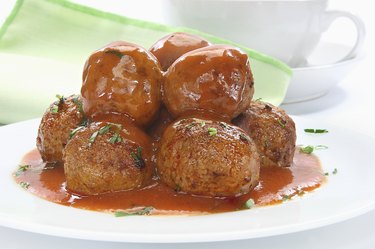
Whether you enjoy them small and unadorned as appetizers, or slathered in tomato sauce for the quintessential Italian-American pasta dish, meatballs work with a variety of flavors. From sweet and herby to spicy, meatballs show up in several types of international cuisine, leaving cooks ample scope for experimentation.
Preparation Basics
Video of the Day
Combining a lean and a fatty meat, such as beef and pork, is the standard approach for creating meatballs that are moist on the inside and crisp on the outside. Adding binding agents such as breadcrumbs and beaten egg to the mixture also keeps the balls tender and spongy. After shaping the meat into balls with their hands, smeared in oil to prevent sticking, cooks can either roast the meatballs on a baking tray in the oven, or pan-fry them first to brown the surface and seal in the flavors. Whatever spice and herb combination you choose, do not overlook the salt. As Bon Appetit emphasizes, good meatballs should be salty, with at least a teaspoon of salt per pound of meat, or a bit less with salty cheeses such as Parmesan or pecorino in the mix.
Video of the Day
Mediterranean Herbs
Without herbs, meatballs taste like little more than plain burgers. To raise the stakes, finely chopped garlic and onion flood the meat with aroma during baking and help with caramelization if you sear them in the pan first. Epicurious recommends adding flat-leaf Italian parsley for classic Old Country meatballs, while Lidia's Italy adds a hint of cloves for meatballs made with a half-and-half pork/beef mix. In general, aromatic Mediterranean herbs such as basil, oregano and marjoram all complement the meat well and bring out its sweetness without overpowering the flavor. Final flourishes include nutmeg or chopped red chili, a Gordon Ramsay favorite.
International Flavors
For spicy meatballs with a satisfying kick, try a mix of ginger, curry powder, cumin, garam masala and paprika or cayenne pepper, finished with fresh coriander leaves. Often rolled into smaller balls than those used in pasta dishes, these don't need as much salt and can even be baked without tomato sauce, for serving with a salad rather than heavy pasta. To offset the heat, pair the meatballs with a cucumber and yogurt dip. Asian meatballs also tend to be lighter and more delicate, typically using ground pork. Cilantro, soy sauce, sesame oil, lime juice and sugar provide the familiar Asian marriage of salt, sweet and sour. Include chili flakes to introduce heat.
Meat Combinations
For Greek-inspired meatballs using lamb, which typically lean heavily on feta cheese for their saltiness, The New York Times recommends familiar Mediterranean stalwarts such as parsley, oregano, garlic and pepper, although a sprinkling of ground cinnamon tempers the feta's strong flavor nicely. Pork also makes a satisfactory meatball, although the leaner meat can give it a tougher texture. In this case, the Times suggests including chopped mushrooms for a little bounce, and chopped rosemary for the herbal note. Veal's succulent texture but relatively unobtrusive flavor opens up the opportunity to showcase aromatic herbs such as sage, oregano and thyme, once more in homage to the dish's Italian heritage.
- The Kitchn: How to Make Meatballs
- Lidia’s Italy: Spaghetti and Meatballs
- Epicurious: Nonnas Old Country Meat Balls
- Red Online: Gordon Ramsay’s Italian Meatballs
- Bon Appetit: The 8 Most Common Meatball-Making Mistakes
- BBC Good Food: Spicy Meatballs
- Epicurious: Asian Meatballs with Sesame Lime Dipping Sauce
- The New York Times: Lamb Meatballs in Greek-inspired Tomato Sauce
- The Kitchn: Spice Lamb Meatballs
- The New York Times: Pork Meatballs with Rosemary
- Gourmet Traveller: Baked Veal and Sage Meatballs with Soft Polenta